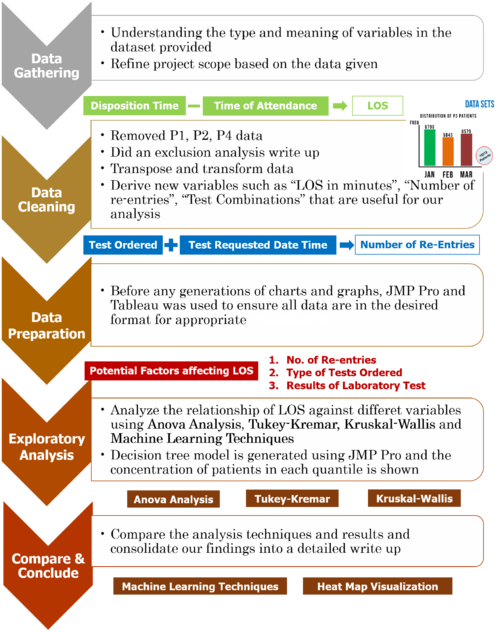Emergency Department Project Overview
Contents
PROJECT BACKGROUND
This project plans to make use of the real data set provided by Singapore General Hospital (SGH) to find out if there is any relationship between the variables. The dataset available includes fields such as the demographics of patients, time of visit and the type of tests ordered, based on historical records within the Emergency Departments (ED).
THE MOTIVATION
Being one of the most important departments in the hospital, it is crucial that the ED is able to serve patients efficiently, within the shortest time span. However, there is currently the constraint of long waiting times and a lack of doctors, which hampers the effectiveness of this department.
At the moment, tests are only ordered upon the consultation of the doctor, and this means that the patients have to wait twice- once to see the doctor for tests to be ordered, and another time after the test results are received. Based on our understanding of the process, our team believes that this waiting time can be reduced by ordering the tests at the triage level, right when the patient enters the ED, doing away with the first stage of waiting.
However, a potential limitation of this is the availability of senior doctors to make an appropriate and accurate judgement call at the initial juncture. Therefore, our team has identified analytics to as a way to circumvent this, by using historical data to predict the tests that are usually ordered in similar situations, allowing quicker and more accurate decisions to be made.
PROJECT OBJECTIVE
In this project, we aim to:
- create a predictive model which allows hospitals’ ED to provide automated orders of clinical tests for its patients at Triage, so as to improve the overall length-of-stay of patients.
- improve the patient flow in the ED, a simulation model will be created- where users will be able to determine the required tests to be run at triage level.
- reduce the waiting time as tests are able to be ordered based on past trends before further consultation with the doctor
- come out with a model which has a certain confidence that the tests ordered will not be redundant.
PROJECT SCOPE
The following are the scope of this project:
- Limited to a six-month-period-data set that is made available by SGH, which would then be unable to capture yearly time seasonality if there is any
- The use of data collected from less urgent medical cases and not from those that require immediate critical care (e.g. Resuscitation)
PROJECT METHODOLOGY
PROJECT DELIVERABLES
- A detailed write up for our findings and to provide insights for the data we obtained
- A classification model to determine the patients LOS based on a number of variables such as type of test ordered, number of re-entries as well as the test results.
- Literature review of our analysis topic
PROJECT CHALLENGE
The challenge for this project will be:
- the data are limited by the amount of information that SGH are willing to provide as many fields are confidential. This might hinder on the accuracy of analysis that we make.
- the team has limited knowledge regarding medical conditions. We feel that this poses a challenge in truly understanding the task at hand.
